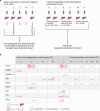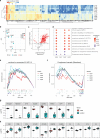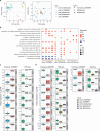Metagenomic and transcriptomic investigation of pediatric acute liver failure cases reveals a common pathway predominated by monocytes
- PMID: 40099881
- PMCID: PMC11980388
- DOI: 10.1128/mbio.03913-24
Metagenomic and transcriptomic investigation of pediatric acute liver failure cases reveals a common pathway predominated by monocytes
Abstract
In 2022, a cluster of severe childhood hepatitis was detected primarily in Europe and North America, leading to a global alert by the World Health Organization. An association with adeno-associated virus 2 (AAV2) in conjunction with human adenoviruses was found. Five percent of the cases progressed to acute liver failure, necessitating transplantation. The mechanism of disease that accounts for fulminant liver failure in these patients remains incompletely described. An upsurge was observed of in the five total cases of acute liver failure that presented to the Dutch national referral center for pediatric liver transplantation in the spring of 2022. An in-depth molecular analysis of the mechanism of pediatric acute liver failure was performed using targeted transcriptomics and metagenomics to identify any virus present in the cases, immune profile haplotypes, and differentially expressed gene groups. Explanted liver tissue and plasma samples (n = 15) were subjected to viral metagenomic and human transcriptomic profiling, targeting >600 inflammatory genes. Liver transcriptomic signatures of transplanted cases were compared with those of pediatric controls from a liver biobank (n = 6). AAV2, adenoviruses, and herpesviruses were detected in liver explant tissue and plasma samples of the cases. Epstein-Barr virus and varicella zoster virus infection with pathognomonic clinical symptomatology preceded liver failure in two respective cases. AAV2 was detected in one-third of control livers. Excessive activation of monocyte pathways was detected in liver explants from cases compared with controls. Remarkably, this signature was comparable for AAV2, adenoviruses, and/or herpesviruses-positive transplant cases. Our multi-omic findings suggest a common transcriptomic profile, with an upregulation of monocyte pathways in the presented transplanted cases, which had similar severe clinical outcomes. In the cohort presented, AAV2 was not exclusively associated with acute liver failure, suggesting that other processes may have contributed to a uniform cascade of irreversible pathology.
Importance: Since the appearance of the cluster of pediatric hepatitis of unknown origin in 2022, several groups have reported an association of adenoviruses and AAV2 in a high number of cases in contrast to controls. The adenoviruses detected were heterogeneous in both species-adenovirus C and F-and sequences. The mechanisms of disease that accounts for fulminant liver failure, occurring in 5% of pediatric hepatitis cases, remain incompletely described. The current study adds to previous data by including pediatric acute liver failure cases during the upsurge, enabling the analyses of inflammation expression profiles in cases with different viruses in relation to pediatric controls. This led to the discovery of transcriptome upregulation of monocyte pathways in liver explants from the cases. This inflammatory transcriptomic signature was comparable for AAV2, adenoviruses, and/or herpesviruses-positive transplant cases.
Keywords: adeno-associated virus; childhood hepatitis; metagenomics; transcriptomics.
Conflict of interest statement
The authors declare no conflict of interest.
Figures



References
-
- World Health Organization . 2022. Disease outbreak news; acute hepatitis of unknown aetiology in children - multi-country. Available from: https://www.who.int/emergencies/disease-outbreak-news/item/2022-DON400
-
- Lexmond WS, de Meijer VE, Scheenstra R, Bontemps STH, Duiker EW, Schölvinck EH, Zhou X, von Eije KJ, Reyntjens K, Verkade HJ, Porte RJ, de Kleine RH. 2022. Indeterminate pediatric acute liver failure: clinical characteristics of a temporal cluster of five children in the Netherlands in the spring of 2022. United European Gastroenterol J 10:795–804. doi:10.1002/ueg2.12269 - DOI - PMC - PubMed
-
- Morfopoulou S, Buddle S, Torres Montaguth OE, Atkinson L, Guerra-Assunção JA, Moradi Marjaneh M, Zennezini Chiozzi R, Storey N, Campos L, Hutchinson JC, et al. . 2023. Genomic investigations of unexplained acute hepatitis in children. Nature New Biol 617:564–573. doi:10.1038/s41586-023-06003-w - DOI - PMC - PubMed
MeSH terms
LinkOut - more resources
Full Text Sources

